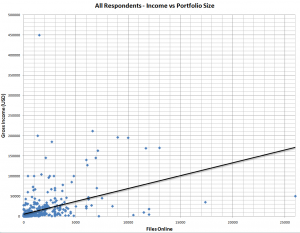The Link Between a Contributor’s Earnings and Portfolio Size
0
I came across an intriguing analysis by Tyler Olson for 2010 and thought many would find it useful. The research summarizes the results of a large survey of microstock contributors.
The study focused specifically on contributors’ earnings. Using the data, Tyler attempted to infer how portfolio size correlates with a contributor’s income. Using these insights, a contributor can roughly estimate expected earning levels and set realistic targets for growth.
Earnings vs. Portfolio Size
Simply browsing leaderboards or peeking at others’ stats makes it very hard to estimate how much one can make on microstock with a portfolio of 100 or 500 images.
So much depends on style, originality, quality, variation, and other factors. The chart clearly shows substantial spread in earnings.
Still, some trends do emerge, which is useful for benchmarking whether a contributor’s microstock income is above or below the main trendline.
On average, as the chart suggests, a microstock contributor earns about $10.28 per image per year, or roughly $0.87 per month.
The Value of Exclusivity
After filtering out responses with zero portfolio size or missing income values, 522 valid responses remained for comparison.
Below is a comparison of earnings for exclusive iStock contributors versus non-exclusives.
Raw numbers:
Non‑exclusive: 394
Average portfolio size: 1,383
Portfolio size median: 505
Average annual earnings: USD 9,265
Annual earnings median: USD 2,000
Exclusive: 128
Portfolio size median: 1,548
Average portfolio size: 1,000
Average annual earnings: USD 31,385
Annual earnings median: USD 12,405
Wow! Frankly, it’s surprising. The expectation might be that non-exclusives earn more, yet the chart shows the opposite.
If there’s any consolation for non-exclusives, it’s that there are relatively few data points in the top half of earnings (for both groups), making precise conclusions difficult. Another explanation is that many exclusive contributors treat microstock as a serious professional endeavor.
Before one can qualify for exclusivity, requirements typically include at least 250 downloads with a 50% acceptance rate, or 500 downloads with a lower acceptance rate. In other words, exclusives tend to operate at a higher professional level.
As a happy non-exclusive, it’s still worth unpacking what the chart indicates, even if it looks like iStock exclusives do less and earn more. The data certainly points in that direction.
It will be interesting to see whether this trend holds over the coming years.
Part‑time or Full‑time?
This comparison may not be essential, but it’s insightful. The idea was to compare earnings between full‑time and part‑time microstockers.
Contributors who derive at least 50% of their primary income from microstock were considered full‑time. Those earning less than 50% from microstock were treated as part‑time.
Again, responses without clear portfolio size or income were excluded to improve reliability.
Raw numbers:
Part‑time, respondents: 403
Average portfolio size: 1,089
Median portfolio size: 512
Average annual earnings: USD 6,774
Median annual profit: USD 2,018
Full‑time, respondents: 119
Average portfolio size: 2,851
Median portfolio size: 2,100
Average annual earnings: USD 44,667
Median annual profit: USD 20,500
These findings are unsurprising: respondents whose primary income comes from microstock generally earn more than part‑timers.
A key takeaway is that major income growth stems less from sheer portfolio size and more from the revenue each image generates within the microstock portfolio.
Thoughts
So, what do you think? Why, for example, do iStock exclusives earn more than non‑exclusives? What does this study suggest about your own future in microstock – is it encouraging or discouraging?
Original source
Author: Tyler Olson
Link: blоg.microstockgroup.com/microstock-income-vs-portfolio-size/






